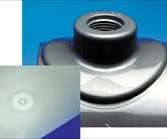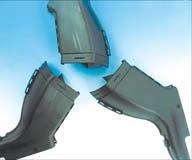Eliminate Surface Defects on Molded Parts
Visible defects on the surface of a molded part appear as dull, glossy, or hazy areas, or as a rippled surface, called orange peel.
Visible defects on the surface of a molded part appear as dull, glossy, or hazy areas, or as a rippled surface, called orange peel. Common points of occurrence include near the sprue or behind sharp edges in areas away from the sprue. The mold and the molding process are the best places to seek out and identify the causes of these effects.
Dull areas on the part
Dull concentric rings can appear around the sprue like a faint halo. This is most likely to occur when the part is made from a high-viscosity, poorly flowing material such as PC, PMMA, or ABS. With this type of polymer there is the risk of the cooled surface layer near the gate being displaced by the flow of resin in the core of the part, leaving a visible defect.
It is frequently assumed that the defect occurs during the packing and holding-pressure phase of the process. Yet in fact, dull areas near the sprue invariably occur at the beginning of the filling cycle. Our experiments have traced the actual cause of the skin-layer displacement, which can be attributed to injection speed—more specifically, the flow-front velocity.
Even when injection speed into the mold is constant, flow velocity changes. Flow velocity is very high in the area of the gate as it enters the mold, but slows down as the flow front extends away from the gate and into the cavity on a widening circle. The change in flow-front velocity can bring about the surface defects.
One way to reduce the changes in speed of the flow front is to tailor the injection-speed profile. In order to obtain a slow flow-front velocity near the sprue, it is necessary to inject in several steps, increasing gradually from a relatively low speed to ones that are faster and faster. The aim is to obtain a flow-front velocity that is uniform throughout the whole filling phase.
Low melt temperature is another source of a dull surface on the part. Increasing the barrel temperature and raising the screw backpressure can help reduce the probability of surface defects. Too low a temperature of the mold wall can also be a reason, so increasing the mold temperature is another possible solution to surface defects.
There are also design-related issues that can generate a dull area near the sprue. A sharp transition between the gate and part can be remedied by providing a small radius between the gate and the part. Also, take a closer look at gate position and diameter and confirm that they are correct for the application.
Dull areas occur not only near the sprue but are also frequently found downstream of sharp edges in the molded part. In such a case, the surface finish up to the sharp edge is typically very good, while behind it the surface is dull and rough. Here again, too high an injection speed or flow velocity can cause the cooled surface layer to be displaced by melt flowing underneath.
A stepped or graduated injection speed profile is again recommended. The best approach is to allow flow to speed up only after the flow front has passed the sharp edge.
A design-related source of trouble involves sharp transitions at edges in the molding away from the sprue area. A smoother, radiused transition in those areas is the answer.
Fixing gloss variations
Differences in gloss are most conspicuous on textured surfaces. Irregular gloss may appear on the molded part even though the mold has a uniform surface texture. The problem is poor replication of the mold surface in some areas of the part.
Pressure on the injected melt decreases with increasing distance from the gate. If the part is not fully packed at the point farthest from the gate, where the pressure is lowest, the mold surface texture will not be reproduced exactly, resulting in a glossy surface. Hence, unwanted gloss is least likely in the areas where cavity pressure is strongest—from the gate to about half way along the flow path.
To fix this situation, consider raising the melt or mold temperature or the holding pressure. Extending the holding-pressure time also may increase the chances for accurate mold-surface replication.
Part design can also contribute to gloss variations. For example, large changes in wall thickness can cause melt-flow irregularities and difficulties in mold-surface replication. Designing more uniform wall sections can alleviate this. Areas of excessive wall thickness or oversized ribs can also increase the risk of glossy marks. Another source is insufficient venting at the flow line.
Orange peel’s origin
“Orange peel” or a rippled surface defect typically occurs at the end of the flow path in thick-walled parts molded of high-viscosity materials. During injection at low velocity, solidification occurs on the surface too quickly. The high resistance to flow produces uneven frontal flow, and the solidified outer layer will not fully contact the cavity wall. The result is ripples. These ripples will freeze and holding pressure will no longer be able to smooth them out. The solution is to raise the melt temperature and increase the injection speed.
Now retired, Martin Bichler is a former long-time employee of Demag Plastics Group in Schwaig, Germany. Bichler was formerly head of application engineering and processing development. Since his retirement, he continues to work closely with Demag as an application advisor and symposium lecturer. He focuses on the basic aspects of injection molding and has published a book in English, Guide to Flawless Injection Moldings. For questions or comments on this article, contact Bob Lewis at Demag in Strongsville, Ohio. Tel: (440) 876-8960,or e-mail applicationsgroup@dpg.com.
Related Content
Improving Twin-Screw Compounding of Reinforced Polyolefins
Compounders face a number of processing challenges when incorporating a high loading of low-bulk-density mineral filler into polyolefins. Here are some possible solutions.
Read MoreThe Effects of Stress on Polymers
Previously we have discussed the effects of temperature and time on the long-term behavior of polymers. Now let's take a look at stress.
Read MoreThree Key Decisions for an Optimal Ejection System
When determining the best ejection option for a tool, molders must consider the ejector’s surface area, location and style.
Read MoreBack to Basics on Mold Venting (Part 1)
Here’s what you need to know to improve the quality of your parts and to protect your molds.
Read MoreRead Next
Making the Circular Economy a Reality
Driven by brand owner demands and new worldwide legislation, the entire supply chain is working toward the shift to circularity, with some evidence the circular economy has already begun.
Read MorePeople 4.0 – How to Get Buy-In from Your Staff for Industry 4.0 Systems
Implementing a production monitoring system as the foundation of a ‘smart factory’ is about integrating people with new technology as much as it is about integrating machines and computers. Here are tips from a company that has gone through the process.
Read MoreBeyond Prototypes: 8 Ways the Plastics Industry Is Using 3D Printing
Plastics processors are finding applications for 3D printing around the plant and across the supply chain. Here are 8 examples to look for at NPE2024.
Read More
















